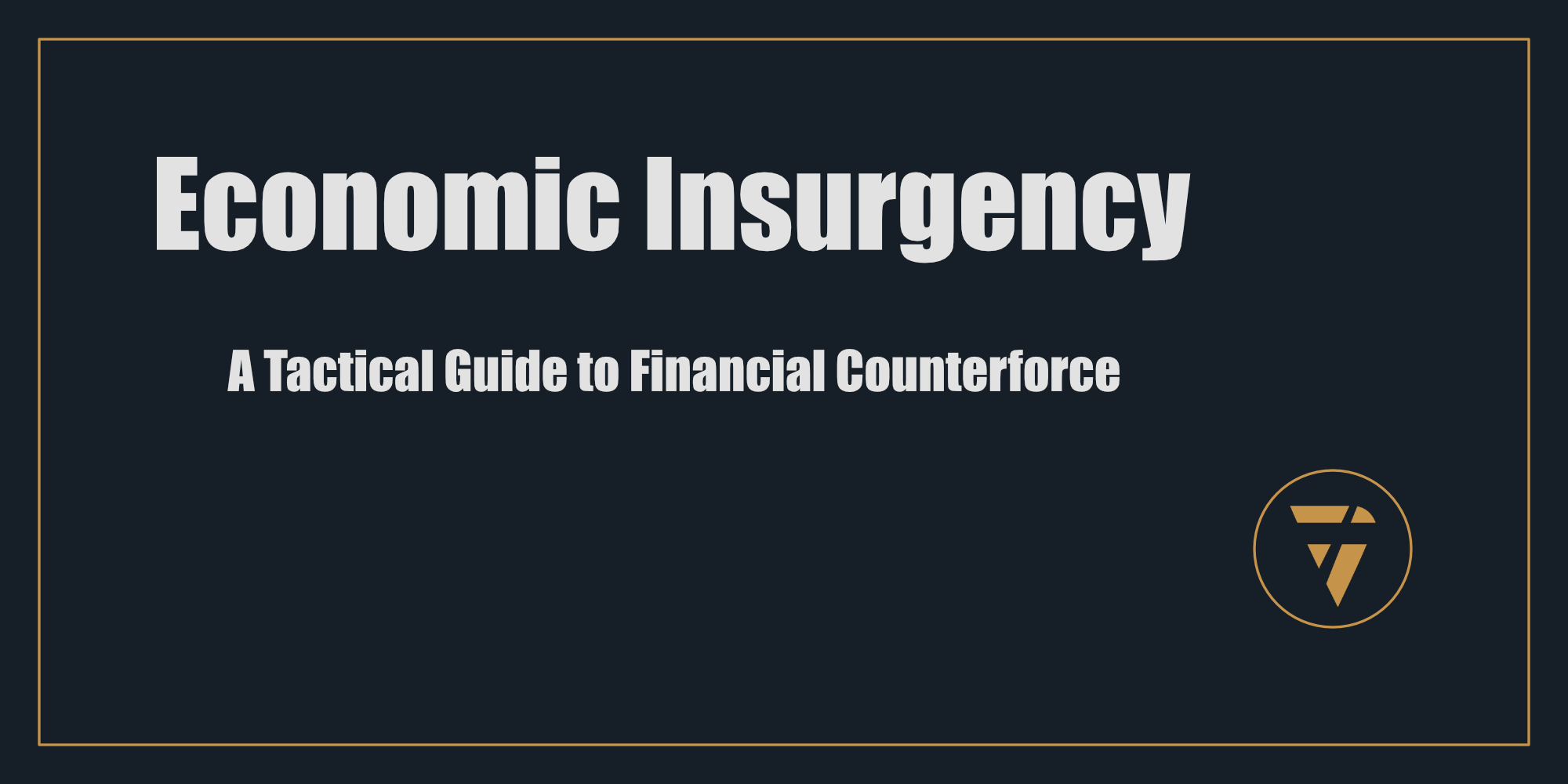Economic Insurgency

A Tactical Guide to Financial Counterforce
To build is to create. To take something from nothing, and make it into a system, a structure, a solution. It is the work of those who shape the future, who produce real value... those who take risks and bear the consequences.
Kevin O’Leary does not create. And he doesn't know consequences. He extracts. He is not an architect of industry, but a parasite of it, a man whose entire career has been dedicated to finding ways to skim profit without adding value. He does not design, innovate, or build—he inserts himself between those who do, and the money they should rightfully earn.
Fuck O’Leary, SUPPORT COSTCO!
— Isabel Santos (@isabelsantos.bsky.social) 2025-02-02T11:32:45.965Z
And yet, he talks.
O’Leary talks about business, as if he understands it. He talks about investment, as if he creates wealth rather than hijacks it. He talks about economics, as if his financial opinions should carry weight. He talks, and the only reason anyone can hear him, is because money turns up the volume.
That volume can be turned down. And then, it can be turned off.
Economic power is not intrinsic. It's not something granted by divine right. It's a product of systems, relationships, and cash flow. Every billionaire, every corporate overlord, every right-wing economic propagandist exists only because the money keeps coming in.
That flow can be disrupted. That revenue can be taken. That influence can be neutralized.
This is economic insurgency. This is financial counterforce.
I. The Illusion of Power
There is a dangerous myth that people with money have money because they are better, smarter, or more capable than the rest of us. That they have some ineffable quality that justifies their wealth and influence. But wealth accumulation has never been about intelligence or innovation—it is always about extraction, gatekeeping, and control.
The economic elite thrive not because they create, but because they capture and monopolize markets, industries, political influence, and public attention. They operate under the assumption that no one will challenge them on their own playing field.
But that assumption is about to be tested.
This is not a manifesto. This is a manual for financial counterforce.
Economic insurgency is not a protest. It's not a boycott. It is a strategic offensive designed to seize economic power, and deny it to those who have abused it. It is a market-based war of attrition where billionaires and their enablers lose, because we outcompete them.
O’Leary, Smith, and every other wannabe fascist oligarch do not need to be fought. They need to be made obsolete.
II. The Three Pillars of Economic Insurgency
Every billionaire’s power is built on three things:
- Capital Flow – The continuous stream of investments, partnerships, and revenue that fuels their influence.
- Market Capture – The monopolization or control of industries, preventing alternative competition.
- Public Legitimacy – The perception that they are too valuable or too powerful to challenge.
Economic insurgency requires us to systematically dismantle all three.
III. Pillar One: Cutting Off Capital Flow
Money is oxygen. No business, no billionaire, no empire survives without a continuous flow of capital.
This is where the first strike begins.
1. Financial Deplatforming
Billionaires do not use their own money to fund their ventures. They use your money. They rely on investment firms, banks, government subsidies, and institutional capital to fuel their growth.
The first step of economic insurgency is exposing and disrupting these financial networks.
- Investment Disruption: Track where billionaires get their funding, who their institutional backers are, and make those relationships toxic.
- Consumer Redirection: No boycott is effective without a better alternative. Launch community-backed, market-driven replacements that steal their customers.
- Financial Attrition: Every dollar that does not enter their ecosystem weakens them. If capital dries up, influence evaporates.
IV. Pillar Two: Market Capture and Replacement
The greatest lie billionaires tell is that only they can build what society needs.
- Only Musk can build electric vehicles.
- Only Bezos can deliver at scale.
- Only O’Leary can invest in Canadian infrastructure.
This is false. They are not building anything new. They are controlling who is allowed to build.
Economic insurgency means we build the same things—but better, m, and without them.
1. Reverse-Engineering Billionaire Business Models
If something is profitable for a billionaire, it is more profitable for a decentralized, collectively owned model.
Every time they announce a new venture, break it down into:
- Where the money is coming from
- What makes it profitable
- How to replace them before they launch
2. Case Study: Alberta Data Centre
Kevin O’Leary sees profit in cloud infrastructure. That means there is an opportunity for someone else to:
- Build a decentralized, co-op-owned alternative
- Create community-driven funding models
- Use public awareness to deny him investment and legitimacy
Instead of letting another billionaire own a critical industry, economic insurgency ensures that we build it first.
- If O’Leary wants to control Canadian digital infrastructure, we take it first.
- If Musk wants to monopolize AI, we launch decentralized AI networks.
- If Bezos wants to own logistics, we create distributed fulfillment networks.
The same process works every time. Break their monopoly. Build the replacement. Win.
And before you tirade, I'm aware it's not easy.
But it is possible.
And you can plan, fund, and execute with specific targets in mind. It's pure capitalism. I'm just suggesting they prove they're better at it. With money, not mouth.

V. Pillar Three: Breaking Public Legitimacy
Billionaires stay in power not because they are untouchable, but because people believe they are.
The final pillar of economic insurgency is destroying their credibility, and making their presence in markets a liability.
1. The Reputation Collapse Model
Every billionaire-backed project has two weak points:
- They rely on public trust.
- They rely on a stable business environment.
Economic insurgency weaponizes both against them.
- Expose their incompetence. Can we please stop with the stupid.
- Prove they are not essential. Every time we replace a billionaire-run business with a community alternative, we show that their presence was never necessary.
- Create high-risk perception. Investors, banks, and corporations hate financial risk. If we make billionaire-backed ventures high-risk, capital will flee.
VI. The Tactical Playbook: From Theory to Execution
Economic insurgency is already happening in fragmented ways. It needs to be organized, weaponized, and executed at scale.
Phase One: Mapping the Targets
Identify the key billionaires and their most financially vulnerable ventures.
O’Leary’s economic and public persona is built on leverage, perception, and other people’s money. He does not have a foundational business empire like Bezos or Musk—he thrives on positioning himself as an authority and inserting himself into profitable ventures. That makes him uniquely vulnerable to targeted economic insurgency.
Here are ten key vulnerabilities that can be exploited to disrupt, neutralize, and ultimately strip him of his ability to generate revenue and influence.
1. Investment Dependency
O’Leary does not self-finance his projects. He relies on outside investors, government incentives, and corporate backers to fund his ventures. If these sources are pressured, exposed, or made high-risk, his ability to execute projects collapses.
2. Lack of Operational Expertise
O’Leary does not build or operate businesses. He markets himself as a dealmaker, but he lacks technical expertise in any industry. If his credibility as a business operator is publicly dismantled, he loses access to lucrative partnerships.
3. Fragile Media-Driven Brand
His revenue is heavily dependent on his visibility as a financial expert. If his brand is discredited—by exposing his failures, hypocrisy, and lack of real business success—his media opportunities shrink, cutting off sponsorships, appearances, and book sales.
4. High Business Failure Rate
O’Leary’s real track record is a string of failed businesses, including:
- The Learning Company, which was sold in a disastrous deal that tanked Mattel’s stock.
- O’Leary Fine Wines, which shut down due to lack of demand.
- O’Leary Ventures, which has yet to produce a major market success.
By systematically exposing his pattern of failure, his reputation as a business leader collapses.
5. Weak Consumer Loyalty
Unlike Musk or Bezos, who have devoted customer bases, O’Leary sells nothing that the public is emotionally attached to. His products—wines, ETFs, investment funds—are easily replaced with better alternatives. Consumers can be redirected away from his financial products with no resistance.
6. Heavy Reliance on Shark Tank Credibility
O’Leary’s legitimacy largely comes from being a TV personality on Shark Tank. If his actual investment track record from the show is analyzed and publicized, revealing how few of his deals succeed, his credibility erodes. If he loses media relevance, his revenue streams dry up.
7. Canadian Political Backlash
O’Leary’s failed attempt to enter Canadian politics left him with no serious political allies. Unlike Thiel or Musk, who have strong ties to right-wing power structures, O’Leary is exposed to political scrutiny and lacks institutional protection. If pressure is applied to his business dealings in Canada, he has no political shield.
8. Scandals and Legal Vulnerabilities
O’Leary has been involved in multiple scandals, including:
- The 2019 boating accident in which his wife was charged after a fatal crash.
- Conflicts of interest related to his financial endorsements.
- Regulatory scrutiny on his investment products.
By keeping these in the public conversation, investors and partners will see him as a high-risk figure.
9. Overextension into High-Risk Sectors
O’Leary frequently jumps into industries he does not understand, from crypto to real estate to data centres. His Alberta data centre is a prime example of a high-risk venture that can be financially disrupted. If it fails, his ability to launch future projects diminishes.
10. No Core Business Empire
O’Leary does not own a dominant business like Tesla, Amazon, or Meta. His wealth and influence are spread across multiple small investments and partnerships. That means he has no fallback if key ventures are systematically targeted. If his investments, funding sources, and credibility are stripped away, he has nothing to fall back on.
The Path to Financial Counterforce
O’Leary is not a self-made titan of industry. He is a media-dependent financial middleman with no core business to sustain him. His vulnerabilities are clear, immediate, and exploitable.
The strategy is simple:
- Choke his investment pipelines.
- Expose his failures.
- Redirect consumers away from his financial products.
- Break his credibility as an investor and businessman.
Take away his funding, his media presence, and his access to easy money, and Kevin O’Leary becomes just another loudmouth with nothing left to sell.
Phase Two: Building the Counterforce
- Funding alternatives – Directing capital into community-driven, co-op-owned projects.
- Competitive market attacks – Launching businesses designed to replace fascist ventures.
- Financial disruption – Targeting the banks, funds, and investors that sustain fascist influence.
Phase Three: Full-Scale Economic Disruption
The final stage is a co-ordinated, multi-sector effort to replace oppressive economic control with decentralized, people-driven ownership.
- Data centres, logistics, AI, manufacturing—every high-growth sector must be reclaimed.
- Venture capital must be decentralized and owned by those who build.
- Infrastructure must belong to the people who rely on it.
The system that has allowed billionaires to rule is not unbreakable.
It is simply waiting for someone to prove it's not profitable.
VII. The Economic Counterforce Begins Now
Billionaires are not invincible. They are only as strong as the financial ecosystems we allow them to manipulate.
They expect anger.
They expect protests.
They expect governments to regulate them.
They do not expect economic insurgency.
The only way to end their influence is to eliminate the cash flow.
The only way to end their power is to end their profitability.
Economic insurgency is not an idea. It is a practice. It's an executable, repeatable, financially devastating method of reclaiming the future from those who have stolen it.
O’Leary talks because money gives him a microphone.
Take away the cash flow, and we never have to hear him again.
More importantly, we never have to hear any of them again.
And then, finally, we can get on with building a functional world.
This is what I’m working on. Tell me what you think, I enjoy the conversation! Subscribe and follow the work in real time.
Thanks!
B

Money is an amplifier. It turns cash into control.
The incessant buzzing of ignorance personified in opinion.
The only reason we have to hear it is because capital keeps flowing.
Cut off the money, and the noise stops.
Then we can get to work.
PS -

This is my statement at the end of the methodology section in my bio. It describes what I can do. Apply it to a fascist, ignorant, dangerous target... so they are no longer a threat.
I will help you target and eliminate revenue from fascist individuals, corporations, and organizations. Who is causing the most damage in your community? Let's stop that from being possible.
“Prove me right and I’m happy. Prove me wrong and I’m grateful.”
I live on proof. It’s the only thing that matters. Everything else is irrelevant.
- Take your entire portfolio. I’ll beat the performance of your best venture, with your worst, in 12 months.
- Give me a list of your top 10 ventures. I’ll show you a 2x revenue opportunity, in every one, that you missed.
- Connect me with every venture you have declined in the last 12 months. I’ll make every one profitable.
- Own more than one franchise, location, or satellite? Let me run the weakest operation for 90 days, and you will convert your entire business.
- VC? You are obsolete. The game changed while you were chasing unicorns. Invest better.
- Take the worst team in the league. They will win next season.
- Only have one business? Double your revenue in 12 months.
I will A/B test my methodology against any business, model, tactic, or implementation.
Verse me.







